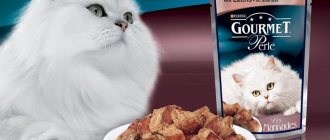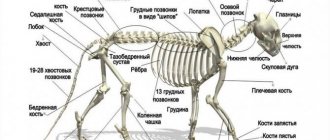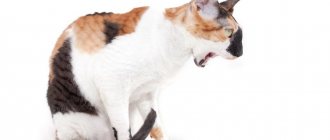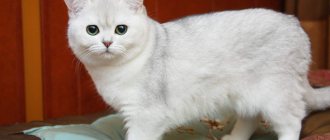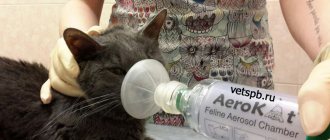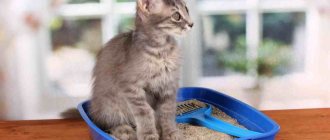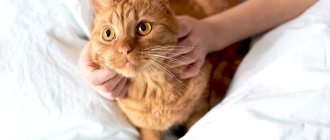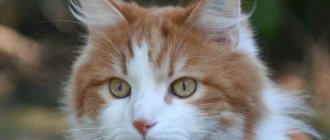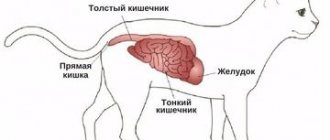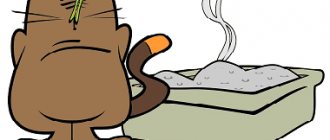Everyone has heard the phrase that a kitten's stomach is no bigger than a thimble. Is it true? Owners of furry pets are concerned that their pets are undernourished or overeating. To understand this topic, you will need anatomical details.
In a kitten, the digestive system has the esophagus, body, sphincter, cardia, antrum and other sections. The body of the stomach of the small and mischievous prankster grows from 4 ml and above in the first months of life. For every 100 grams of animal weight there is about 5 ml of volume.
Through simple calculations, it became clear that a kitten’s stomach could not be smaller than a thimble. This happens if the poor animal was born premature.
Interesting to know! “The size of sewing thimbles has not changed since their introduction. So the volume of a thimble for centuries was about 2 ml, less often a little more.”
By the 10th day of life, all kittens grow, get stronger, and gain weight. Along with your weight, your internal organs also grow. It is known that kittens are weaned from their mother and given to new owners between 2 and 3 months. It turns out that the volume of a kitten’s stomach at 2 months is 40 ml.
It is easy to calculate that this volume is equivalent to 20 thimbles. Thanks to this knowledge, you will understand that you need to feed a kitten correctly, based on its weight, and not on anatomical myths.
The standard volume of a cat's stomach is 300 ml. The digestive organ of an adult animal is single-chambered and does not have the conditions to digest plant foods. This structure of the stomach is characteristic of all representatives of the cat family.
Typically, the size of a cat's stomach depends on the weight of the pet. In large cat breeds, this volume is naturally larger. Those quadrupeds that are obese also have large stomachs, which are able to reduce their volume if the animals lose weight.
Veterinarians claim that a cat’s stomach is no different from the structure of a male’s stomach. A cat's stomach grows along with its body. May become larger depending on the amount of food consumed.
What kind of stomach does an old cat have? Here everything also depends on the pet’s body weight. Age and stomach volume are not correlated. It is believed that the size of a cat's stomach can be compared to a standard cup of tea. Therefore, you should not overfeed the animal by pouring food into a bowl with a mountain.
What is a stomach pit
In fact, no pit is formed in the animal’s stomach. It’s just that the volume of the cat’s stomach becomes so large that it is difficult for her to feel full. The furry animal asks for food all the time. This happens for the following reasons:
- worms;
- childhood psychological trauma;
- distended stomach;
- excess weight.
If the last two reasons are closely related, then the first are treated with regimented feeding, medications and observation by a veterinarian. Since childhood, a kitten's stomach can stretch too much when the pet does not get food at the same time, steals food from the table, undereats, and then overeats. Some kittens do not feel full, but with proper feeding this will go away as they age.
Basic principles of feeding cats
Karl Marx also wrote that human life is unthinkable without three things - food, water and clothing. The life of cats is somewhat simpler in this regard, at least they do not need clothes. But our four-legged friends also cannot do without food and water. In order for a cat to grow and develop normally, the diet must contain all the components necessary for its metabolic processes (proteins, fats, carbohydrates, minerals, vitamins and water).
Feeding is one of the main factors determining the health, productive and usable qualities of animals, as well as their life expectancy, and this is approximately where I begin the conversation with owners of domestic cats who have problems feeding their pets. Every year I notice that my instructions become more and more concise. It is possible that the years take their toll and much is forgotten. Or maybe the reason for this was the massive transition to dry food and canned food. Indeed, the wave of prepared pet foods has divided owners into two irreconcilable camps.
Some argue that they will not calculate how much their pet needs different components of the diet at different periods of life - they do not have time, and they will not be able to do it as accurately as specialists involved in the production of ready-made food.
Others foam at the mouth and prove that they have raised more than one generation of cats on natural products. At the same time, they will definitely point their finger at some mangy cat with urolithiasis from the neighboring apartment, who in their life have not eaten anything else except these “ready-made surrogates.”
Both opinions are not without foundation, but we will not discuss them now because: - the principles of compiling a diet are the same in both cases; - they are based (or should be based) on the physiological needs of the animal.
Principle 1. Optimal diet volume. Still “not knowing how to stop”, the kittens feel that they have satisfied their hunger only after filling most of their stomach with food. Sometimes this happens to adult animals, especially if they get some tasty food. Excessive amounts of food are poorly processed by the secretions of the digestive tract (saliva, gastric and intestinal juices, bile) and simply cannot be fully digested. As a result, most of the nutrients are not absorbed. Getting rid of the feed masses that fill the stomach and intestines comes with vomiting or diarrhea. Their consequences can be very different, but they do not exhaust all possible troubles. An overfilled stomach has a high degree of inertia and, when the animal moves suddenly, it twists around its axis. It is possible to save the life of a carnivore with gastric volvulus only if you consult a veterinarian in a timely manner, and even then not always, because To do this, you must first cut off and then sew this organ to the esophagus and duodenum, on which it hangs.
The required amount of diet is determined for each cat individually. It varies widely both between animals of different breeds having the same weight, and between individuals of the same breed. In general, the amount of food should be sufficient to satisfy hunger without having a long-term significant negative effect on the cat's activity. In most cases, when an animal gets used to a constant feeding regime, its body itself limits the amount of food it takes.
Principle 2. Optimal calorie content. Cat food is, first of all, a source of energy that allows you to maintain a constant body temperature, the functioning of the muscles and all organs of the animal.
Experts from the Waltham Research Center recommend determining the average daily energy needs of animals in temperate climatic conditions using the formula:
E=125 M (0.7) kcal, where M is the animal’s body weight (kg).
A cat's energy needs depend on the ambient temperature, the condition of the coat, gender, age, physical activity and the physiological state of the animal . Animals kept indoors also spend 8-10% less energy than cats constantly living outside or in open enclosures. In the latter, energy needs decrease by approximately 15% in summer, and increase by the same amount in winter. All other things being equal, long-haired cats need less (approximately 10-15%) amount of energy than short-haired cats. Small animals have a more intense energy metabolism compared to large ones. Males expend 5-7% more energy than cats. Greater mobility requires greater energy supply.
During growth, pregnancy, during lactation of a cat and during physical activity, energy needs increase in proportion to its consumption.
With an energy deficiency in the diet, the cat uses its own body reserves , and when they run out, it will begin to lose weight and become less active. Excess energy is also not beneficial - most often its consequence is the formation of abundant fat deposits in the subcutaneous tissue and on internal organs (liver, heart, etc.).
To calculate the energy capacity of the diet using the above formula, you need to know that 1 g of protein “burning” in the body gives 4 kcal, 1 g of fat - 9 kcal, and 1 g of carbohydrates - 3.5 kcal.
Principle 3. Completeness. The amount of fat, protein and carbohydrates a cat needs can be determined without much difficulty. But the nutritional value of the diet is not limited to these components. We must not forget about minerals and vitamins. Without them, the normal course of biological processes is not possible, incl. and absorption of nutrients obtained from food.
Principle 4: Food should be fun. You can create a diet that fully meets the needs of your four-legged friend. But all the work will go down the drain if he refuses this diet or its individual components. The taste of our pets plays a paramount role in this matter, and cannot be ignored. Thus, a properly composed diet should be considered that set of feeds and supplements that not only meets the physiological needs of the animal, but also brings him pleasure.
Principle 5. Harmlessness. The obviousness of this does not need proof. It probably wouldn’t even occur to anyone to deliberately add dangerous or toxic substances to the food of their four-legged companion. But often we do this out of ignorance. For example, do you know what is the most common reason for visiting veterinarians (especially after the holidays)?
But the presence of sugar, starch, wheat (and to a lesser extent corn) flour, raw egg whites, and excess salt in the diet will make themselves felt later (sometimes after several months). Such “excesses” lead to diseases of the skin, pancreas, and digestive tract.
There is also a danger of increased sensitivity of the body of individual animals to certain feeds. Including them in the diet will certainly lead to the development of allergies. Some companies producing ready-made food strenuously instill in their customers the idea that meat is an allergen for many animals. It seems more likely to me that for our smaller brothers, as well as for their wild relatives, it is not meat that causes allergies, but those components of the diet with which they are trying to replace it.
Source: Doctor Dobrodeev, magazine “Between Cat and Dog”, 2002 - 1
How to feed an animal correctly
To avoid stretching your cat's stomach, you need to give food morning and evening at the same hours. Portions should also be fixed. Food must contain vitamins and minerals. If they are not enough, you should include vitamin supplements in the menu. When a cat has enough microelements, he does not attack food.
During pregnancy, the size of a cat's stomach increases due to larger portions. A pregnant mother must receive more food in order to safely bear her offspring. When a cat gives birth and feeds kittens, her portion must be gradually reduced to its previous size to prevent obesity and other diseases.
Food categories and digestion period
All the food we eat can be divided into 4 categories according to the duration spent on its processing and absorption in the stomach:
- carbohydrate (fastest food);
- protein (medium);
- oily (long term);
- food that is difficult to digest (too long).
Let's move on to a more detailed description of the categories:
- Category 1: consists of fruits; almost all soft ones - watermelon, melon, grapes, peach. The exception is fleshy fruit - banana, citrus fruits (tangerine, orange, grapefruit), apple. The nutritional value of bananas, citrus fruits and apples is very high; they take longer to digest than other fruits. Almost all berries, fruit juices, kefir. Fast carbohydrates also include jam, cookies, cake, sweets, chocolate, and honey.
- Category 2: all vegetables (with the exception of pickled vegetables); greenery; semi-finished fish products and fish delicacies; all dairy products, with the exception of cheese and cottage cheese; peanuts, walnuts, hazelnuts (pre-soaked in water); seeds; dried fruits; chicken white meat; chicken egg; quail egg. This food, containing a lot of protein, lingers in the stomach for 90-120 minutes.
- Category 3: porridge (rice, buckwheat, millet); boiled legumes (beans, peas); mushrooms; cottage cheese; some types of bread; walnuts, hazelnuts (not previously soaked in water). The residence time of these dishes in the stomach is 2-3 hours from the moment of consumption.
- Category 4: tea, coffee, hot chocolate; chicken (chicken breast does not count), turkey, beef, lard; pasta (with the exception of pasta made from durum wheat); canned fish; fermented and pickled food. This is food, the digestive activity of which continues at a slower pace, long-term processing occurs, or is completely absent.
What food is best to eat to speed up the function of the stomach for fast and high-quality metabolism? In order not to harm, but, on the contrary, to help the stomach speed up metabolism, firstly, you need to eat those delicacies that are absorbed quickly. Secondly: food belonging to category 4 is not recommended to be consumed daily. Replace pork with chicken meat, as it contains half as much fat. If you suffer from diabetes, then eat all edibles from categories 1 and 2, excluding only sweets - cake, cookies, jam, chocolate. Honey is allowed to be eaten, as it is considered a healthy food produced by bees. Nutritionists recommend replacing sugar with honey.
In a rational and balanced diet, there is a condition called the glycemic index and the table attached to it. GLYCEMIC INDEX (GI) is an indicator that reflects the speed at which a particular food product is retained in the body and how it is broken down. The GI table contains a list of foods with high, average and low scores. GI has a significant impact on weight loss and obesity.
Small intestine:
- breakdown of proteins, fats and carbohydrates (including starch) using enzymes;
- carbohydrate absorption occurs less efficiently than in dogs (due to reduced amylase activity).
The cat's small intestine consists of a large number of loops and occupies a significant part of the abdominal cavity. According to its position, it is conventionally divided into three sections: duodenum, jejunum and ileum. The length of a cat's small intestine is about 1.6 m.
Veterinarian at home
The final stage of the digestive process occurs in the small intestine. As a result of contraction of the stomach muscles, food is mixed and pushed out in small portions into the duodenum. The duodenum receives enzymes from the pancreas, and bile from the gallbladder, which breaks down fats.
Digestion of food occurs throughout the small intestine, through the walls of which nutrients are absorbed into the blood and lymph.
The blood carries nutrients to the liver, the largest gland in the cat's body, which converts them into essential fatty acids and amino acids. Unlike a dog or a human, animal protein is needed to produce the full complex of cat liver acids: if the cat does not eat meat, it will die. The liver performs a barrier function, i.e. breaks down toxic substances and has a disinfecting function (prevents the penetration and spread of harmful bacteria and viruses).
A fibrous membrane divides the liver into left and right lobes. They are divided, in turn, into medial and lateral parts. The left medial lobe is relatively small, the left lateral lobe is significantly larger than it and covers most of the ventral surface of the stomach with one end. The right medial lobe is large; the gallbladder is located on its dorsal surface. At the base of the right lateral lobe there is an elongated triangular caudate lobe, in the anterior section of which there is a papillary process on the left, and a caudate process on the right.
Features and principles of proper cat nutrition
So, the main feature of the cat’s body is that it is 100% a predator. This means that in the wild, a cat eats exclusively meat, and not just any meat, but certainly freshly caught meat (unlike canines, which do not disdain carrion). The main prey of cats are rodents (mice, voles, jerboas and others), birds, less often rabbits and extremely rarely small fish. Therefore, the structure of all the cat’s organs (from claws to vision and smell) is adapted for hunting, catching, eating and digesting such food.
A cat can catch from 8 to 12 victims per day, and not always the first time, so it often returns to the hole or nest to try again. So the cat comes to its bowl in the house many times, demanding from the owner a portion of food and certainly a new one, even if there is still food left in the bowl. This is how the cat realizes its hunting instinct. Unable to catch prey, she uses a new hunting technique - extorting food from her owner.
Instinct tells cats to eat the caught rodent immediately, which is why cats prefer warm rather than cold food.
Another feature of cats is their incredibly developed sense of smell. The smell of food is of primary importance, which manufacturers of low-quality food successfully take advantage of by adding flavorings to food. By smell, a cat can determine not only the freshness of a product, but also its fat and protein content. Cats give preference to fattier foods, and animals are less attracted to vegetable fats. In addition, cats are well aware of the presence of the amino acid taurine in food, which is indispensable for their body and necessary for maintaining sharp vision and proper digestion.
Sensitivity to the taste of food in cats, on the contrary, is quite low. They do not taste sweet things at all, bitter things cause increased salivation, they are weakly sensitive to salty foods, but they like sour tastes.
Cats are conservative in the composition of their food. In the wild, the mother passes on her hunting skills to her offspring, and the prey that the kittens catch becomes the main diet for life. Therefore, the owner’s attempts to please his pet with a new delicacy are perceived by the cat without much joy. You can even argue that your cat will not only not be happy about changing food, but will be categorically against it.
An adult cat can be fed the same type of food for the rest of its life, and it will only be happy about it. Variety in food, of course, is required, but the cat does not accept this. During the complementary feeding period, kittens must be offered as varied a diet as possible. After all, it is impossible to determine exactly where the new owners of the kitten will live and whether they will be able to buy the only food to which you accustom the animal and only to which its intestines will be adapted.
Features of the anatomical structure and functioning of the digestive organs
Well, now let’s look at the features of the anatomical structure and functioning of the digestive organs.
Cats have 30 teeth in their mouth (16 on the upper jaw and 14 on the lower jaw). Developed fangs with powerful long roots, like those of other predators, are designed for catching prey. But the location of the molars will not allow the cat to chew food. Its bite is suitable for eating food according to the principle of scissors, so cats practically do not chew food, but only bite it into smaller pieces.
